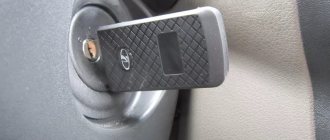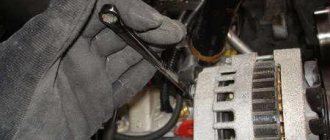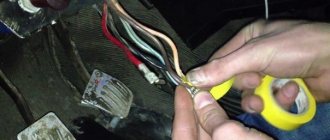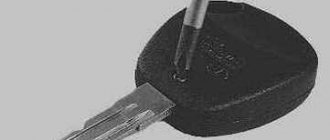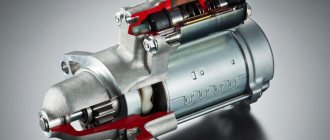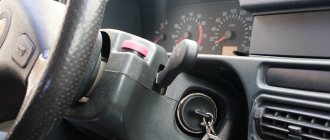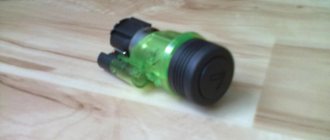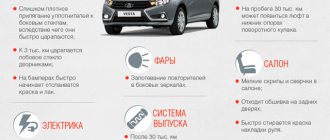To start driving a car, you must first start the engine - every car owner knows this, and even people who are very far from automotive topics. On most cars, the electric charge from the battery is supplied to the starter through the ignition switch contact group. You need to insert the key into the lock, turn it to the first position to turn on the ignition, then to the extreme position. Only then will the starter work. But there are situations when the key does not turn in the ignition. Don't panic. This problem can be solved.
There are several reasons why this annoying malfunction occurs. Let's look at these reasons and repair methods.
Lockout triggered
Any modern car is equipped at the factory with a special steering wheel locking mechanism. This is one of the protective measures that are designed to prevent attackers from stealing a car. If this blocking system has worked, then naturally the key in the lock will not turn, so that it will not be possible to turn on the ignition and start the engine.
Replacing the ignition switch of a VAZ 2110
Replacing the lock with a new one is only necessary if it has already stopped working altogether or if a fairly serious breakdown has occurred; in all other cases, you can get by by replacing the failed parts.
The most common reasons for replacement:
- if the car has been stolen;
- if the key is lost;
- breakdown of the contact group.
Instructions for replacing the ignition switch:
- To carry out this procedure, you need to use special bolts with tear-off heads ; some motorists recommend replacing them with twenty-millimeter M6 bolts , which can be removed more quickly during repeated repairs;
- To loosen the bolts you will need a chisel; during use you need to be extremely careful not to break the bolt head;
- Immediately before replacing the ignition switch, you need to insert the key into it and turn it to position “I” so that the latch, which blocks the steering shaft mechanism, is in the lock body.
- Then you can put the ignition switch on the steering column and secure it with a bracket, also tighten it with bolts for fastening.
- After removing the key from the keyhole, you need to check whether the steering shaft locking mechanism works. If the shaft lock does not work, you will need to adjust the position of the ignition switch on the steering column until the latch fits into the groove on the steering shaft.
- When the locking mechanism is working normally, then using a spanner wrench “10” you finally need to tighten the fastening bolts.
Ultimately, I would like to note that repairing the ignition switch of a VAZ 2110 is not very difficult to perform; you just need to try, and everyone will be able to follow a simple algorithm of actions in order to cope with the task.
The ignition switch (IZ) on a VAZ 2110 car is a device that, as practice shows, quite often fails. To determine the breakdown of the protection device, the driver needs to correctly diagnose the device. You can learn more about checking and the nuances associated with replacing a lock from this article.
When contacts freeze
Russian winters are so severe that in severe frosts the castle also freezes solid. A huge number of situations when the key does not turn in the ignition occur in winter, when temperatures drop below -20 degrees. The thing is that the lock mechanism can accumulate condensation in winter. And then, when the car sits in the cold for a while, these droplets of liquid crystallize, thereby blocking moving parts. As a result, the engine will not be able to start.
The most effective and efficient option is to heat the key with a lighter or a match. The hot element is inserted into the lock and then carefully tried to turn it. If the key does not turn in the ignition the first time (and most often this is what happens), then you need to repeat this operation two or more times.
To prevent the locks from freezing with the onset of cold weather, experts recommend injecting brake fluid into the lock with a syringe and a needle. In the spring, this “well” is thoroughly cleaned with carburetor cleaning fluid. If this is not done, the lock's lubricant will accumulate dust and eventually cause a blockage. This can also cause blocking.
Key programming instructions for Lada Kalina, Priora, Granta, etc.
- Close all doors. Turn on the ignition with the training key and wait in the on state for at least 6 seconds.
- Turn off the ignition. The indicator light in the warning lamp unit should flash quickly (at a frequency of 5 times per second) while the learning procedure is being carried out correctly. If the lamp stops flashing quickly, it indicates an incorrect operation, an out-of-time interval, or a malfunction. Remove the training key from the ignition switch.
- While the warning lamp is flashing (about 6 seconds), insert the remote control and turn on the ignition. The immobilizer buzzer should emit three beeps. If the buzzer does not sound and the indicator has stopped flashing, this means: - the time interval of 6 seconds has been exceeded and it is necessary to repeat the learning procedure, starting from step 1; -immobilizer is faulty
- Wait 6 seconds for the buzzer to emit two more beeps and turn off the ignition.
- If it is necessary to train the second remote control, then you should perform steps 3...4 again, using the second learning remote control to turn on the ignition. If not, continue from step 6.
- After turning off the ignition for no more than 6 seconds, while the indicator is flashing, remove the remote control, insert the learning key and turn on the ignition. The buzzer should beep three times. Wait 6 seconds until the buzzer beeps two more times.
- Turn off the ignition without removing the training key, wait 6 seconds until the buzzer sounds a single sound signal. The indicator should flash twice as fast. If the sound signal does not sound and the flashing indicator stops, you should return to step 1 and repeat the learning procedure. If a repeated failure occurs when performing step 7, this means that the ECM was previously trained with a different key, in which case the controller should be replaced.
- After the buzzer gives a single sound signal, no later than 3 seconds, turn on the ignition for 2...3 seconds and then turn it off (after turning on the ignition, the buzzer will sound three times and the indicator will stop flashing). The hazard warning lights should flash and the car horn should beep.
- Remove the learning key. Wait with the ignition off for at least 10 seconds. Insert the working key and turn on the ignition. Wait 6 seconds, if the indicator does not flash, test start the engine, the engine should start. If the indicator flashes, turn off the ignition and wait at least 10 seconds. Turn on the ignition. The warning light should not flash and the engine should start. If, after turning on the ignition, after 6 seconds the indicator lights up with a constant light, then the learning procedure must be repeated, starting from step 1.
Blockage in the lock
The driver goes outside, opens his car, inserts the key and feels that the key does not turn in the ignition, and it is no longer winter outside. It happens that wells become clogged. During operation, a large amount of various debris easily gets into them. Dirt actively collects (especially if the mechanism has been lubricated with thick lubricants or oils to improve operation).
Ideally, you need to disassemble and thoroughly clean the lock. But this is not always possible. Experienced drivers, in order to continue operating the car without visiting a service station, solve the problem with the universal remedy WD-40.
Clogging and freezing of the larva
Due to dirt accumulated inside the lock, the key jams and jams in various positions. If the jam occurs in the intermediate position indicated by the letters ON and ACC, it cannot be removed. What to do:
- purchase WD-40 lubricant in an aerosol can from your local auto parts store and blow it into the mechanism through the keyhole slots;
- make attempts to turn the key by rotating it in different directions and swinging it in the lock;
- periodically add lubricants to dissolve the dirt inside the larva;
- Gently tap the key head and lock with a light hammer or similar object.
Recommendation. During the manipulations, keep the car on the hand brake. By focusing on the stuck mechanism, you may not notice the car rolling away.
Usually the blockage can be cleared using these methods and the key is turned at least once. This is enough to get to the nearest car service center or garage. If attempts are unsuccessful, it is necessary to dismantle the lock or get to the contact group in another way. Without disconnecting the wires, turn the shaft with a screwdriver and start the motor. Do not touch the key - you may accidentally engage the mechanical lock.
A frozen mechanism is “treated” by warming it up . Pouring hot water is not allowed: just heat the key with a lighter, insert it into the well and try to turn it. The second option is to fill the mechanism with warm WD-40 lubricant from a heated can.
Wear of contact group surfaces
During the operation of the car, the place where the metal elements come into contact with each other is wiped off. Due to this, the gaps grow. The key itself and the elements of the lock mechanism may become worn out.
In the first case, if the key in the VAZ ignition switch does not turn, visually check the condition of the key. If its teeth are rounded, and its width or length has noticeably decreased, then it should be replaced. For comparison, take a second spare key. But it’s better not to use it on a daily basis. Experienced motorists recommend making a duplicate. If you continue to use the second key, then someday the situation will repeat. And then you will have to change the lock.
It must be said that you can find out about a worn key or lock much earlier than jamming occurs - if the key in the ignition switch does not turn well, then this is the first call. If the key is stuck due to abrasion, you can usually try to find a position where the key can engage the secret part of the lock. To do this, carefully turn and press the key into the lock hole many times.
Repair of ignition switch VAZ 2110
The entire lock as a whole is not very expensive, although most of the breakdowns can be fixed quite easily; to do this you will need to dismantle it, disassemble it and then replace the parts that are faulty.
To replace the contact group of the VAZ 2110 ignition switch, you will first need to release the latches so that some of the parts can be freely removed from the body. After this you can easily install a new group. You will not be able to mix up the sides for installation, because the part simply will not fit on the other side.
Instructions for replacing the contact group:
- First you need to disconnect the plug that goes into the backlight. Using a screwdriver, you need to bend the 3 latches that are fixed by the plastic cover, then you can remove it from the lock.
- To gain access to the contact group, you need to bend 2 more latches.
- Then you need to inspect the light guide plate and check if there is a black coating and other deposits. If you find any, you can remove these defects with fine sandpaper. If after this there is no result, then you can replace it.
- Under the light guide plate there are 3 more plates, which are also prone to oxidation, as a result of which the contact group may malfunction. They can also be cleaned with sandpaper.
If you just want to do preventive maintenance for the contact group , then once every six months it is enough to lubricate the contacts with penetrating or graphite grease , which would effectively counteract the oxide. Choosing a lubricant is a very serious and complex procedure. When buying, you should not take the cheapest one. I would like to note that there are several types of lubricants: light (not thick) and heavy (thick). Some car enthusiasts use aerosol penetrating lubricant “liquid key” or WD-40.
Deformations
Often the main cause of problems with the operation of the lock is the key. It is subject to deformation. Damage occurs in various cases (for example, when a car owner opens beer bottles with this key).
Deformations of the lock's secrets occur even more often. This leads to the ignition switch breaking. In this case, only dismantling the lock and removing crumpled springs and slats will help. Often in modern cars, only complete removal of all the lock's secrets helps. After this operation, the car starts even with an ordinary screwdriver. Naturally, if the ignition switch is torn out and the key does not turn, the Mercedes can be easily started even with a Swiss Army knife. This is the only option to get to the service and replace the element.
If the Priora does not start well when hot
In this case, see the second table; in addition to the reasons described, also pay attention to:
- A pressure regulator that can discharge fuel through a membrane into the receiver.
- DPKV contacts, if the sensor has been changed, check that the poles are connected correctly.
- Faulty ignition module.
Let us remind you that in some cases the Priora does not start due to a faulty immobilizer or alarm system. In some cases, reflashing the engine ECU (electronic control unit) helps solve the problem of poor starting. And regular car maintenance will help eliminate problems of poor engine starting.
Source
Other reasons
Sometimes it is much easier to solve a problem, since the reason is very trivial. For example, if on models with automatic transmission the key in the ignition does not turn (“Opel Vectra C”, for example), then you should not exclude a problem with the position of the box. Some car models are designed in such a way that the key cannot be turned until the selector is in neutral or park.
An unpleasant surprise
Of course, the first thing you think about when the ignition switch is stuck is that you can’t type in polite company. Let's not focus on this. You will immediately understand that something is wrong when, despite the key being inserted, the steering wheel remains locked. Sometimes it helps, as it once did on Soviet classics, to jerk the steering wheel and key simultaneously left and right, without fanaticism, naturally. Then the jammed lock will turn, the steering wheel will unlock and then everything will go as normal. On the one hand, this is an optimistic scenario. On the other hand, you should immediately go to the service center (or to the store for a new lock), since what worked the first time will not necessarily work the second time. In such a situation, it is stupid to hope for “maybe”, because it is at least dangerous. The lock may jam while moving, and this may well cause an accident.
Renovated or new?
It would seem that what could be simpler than replacement if the key does not turn in the ignition? Whether it’s a Toyota or a domestic VAZ, it doesn’t matter. But it's not that simple. Buying a lock at a salvage site is not suitable for many people, since a used element will be in the same condition and is unlikely to last long.
To start the vehicle moving, you need to start the power unit - both experienced motorists, novice drivers, and those who never drive at all know this. In most cars, the electric charge from the battery is supplied to the starter via a contact group. An appropriate key is required, set it to the first position to start the ignition, and then turn it to the extreme position. Only after these actions does the starter operate. But sometimes the key does not turn in the ignition, and manipulations with it do not bring the desired result . No need to panic. This problem can be solved quite easily .
How to remove and install the part?
If the ZZ is not working, then it needs either repair or replacement. The ignition switch on a VAZ 2110 is replaced only if the device cannot be restored or repaired. In all other cases, you can and should try to repair it.
So, for repairs, do not forget to disconnect the battery and follow these steps:
- First of all, you need to unscrew the screws that secure the mechanism. First, the on-board network is de-energized; to do this, remove the “-” terminal from the battery. After the plastic cover is removed, the steering column switches are disabled. In this process, removing the bolts is one of the most difficult steps. This is because VAZ engineers initially thought through this point so that in the event of a vehicle break-in, an attacker would not be able to quickly unscrew the unit. Therefore, even at production, the edges of the screws are cut off, so you will have to use a chisel to dismantle the screw. Using a chisel, you only need to move the heads a little from their place, after which the bolts can be unscrewed without any problems using pliers.
- When the protection is removed, it is necessary to understand what the essence of the problem is. If you need to replace the backlight bulb, you should first disconnect the connector. Using small pliers, remove the lamp socket itself. Just replace it with a new one and install it back.
- If the problem lies in the operation of the contact group, then you need to either repair it or replace it. As practice shows, repairs often give the necessary results. However, the cost of new elements for a contact group is often not much lower than the price of the group itself. So, to prevent possible problems in the future, it is advisable to completely change the group. To replace using a screwdriver, you simply need to press the latches and remove the component. In the same way, only in reverse order, a new one is installed in accordance with the ignition switch diagram.
- If you need to change the key controller switch, use a Phillips head screwdriver to remove three bolts. Then the rod is removed from the structure, and then the latch is released and the switch itself is dismantled. Finally, you just need to install a new element in place of the old one.
- As for installation, in general there is nothing complicated about it - all steps must be repeated, only in reverse order. But during the installation there is one point that should be taken into account. Before starting reassembly, set the key in the lock to the first position. In this position, locking the steering wheel will be impossible. Therefore, the latch, located on the shaft itself and performing the function of a lock, should easily fit into the corresponding connector on the 3Z itself. Only after these steps can the device be installed. In addition, for installation you will need new 3Z fixing fixtures, since it will be impossible to install the old ones. When installation is complete, you need to make sure that the steering wheel will lock when the key is removed. If this does not happen, then you will also have to adjust the position of the ZZ on the column.
The request returned an empty result.
Castle design
Before answering the question why the key gets stuck in the ignition switch, you need to look at how the locking mechanism works . The basis of all locks is the cylinder. This is an element that determines the privacy category of the device.
The key does not turn in the ignition
In the simplest mechanism, the larva has the shape of a cylinder, which has a different number of diametrical recesses (4-10). Each of them is equipped with its own spring-loaded plate, which, when the original key is fully inserted, sinks to the same level as the cylinder. And this element has the opportunity to rotate freely inside the locking mechanism as long as the activator key is present in it. In turn, the larva is combined with other nodes:
- contact group;
- steering lock device.
Causes of failures and their elimination
There are a number of reasons that provoke this unfortunate misunderstanding. Let's talk in more detail about the reasons and possible options for correcting the situation. Among the most common reasons why the key does not turn in the ignition switch is this:
- activation of the steering lock system;
- freezing of the unit due to negative temperatures;
- lock blockage;
- elementary wear and tear of the device;
- deformation of the lock itself or the activating key.
Next, we’ll talk in more detail about each of the reasons.
Steering wheel lock
Recently, all cars already on the assembly line receive a special element that blocks the steering wheel in the event of an unauthorized attempt to start the engine. When the system is blocked, the key will not turn, so that the power unit will not start when the ignition is turned on.
Ignition key
What should I do if the ignition key does not turn as a result of the lock being activated? In such conditions, professionals advise finding a location for the steering wheel where both the steering unit itself and the locking mechanism are unlocked. This is accomplished by certain actions:
- Place the key in the lock mechanism.
- At the same time, turn the steering wheel in different directions.
This will help set the key to the engine start position. But the main thing is that in one of these positions the lock will be unlocked.
Freezing contacts
In winter we have such severe frosts that the locking mechanism freezes tightly. Most often, situations with difficulty turning the key in the locking mechanism occur precisely in winter , when the temperature drops below -20ºС. This happens because the lock assembly collects condensation. And then, after standing in the cold for a while, the drops freeze, blocking the moving parts. As a result, the engine will not be able to start.
Ignition switch frozen
In such a situation, experts recommend simply warming up the locking mechanism. This can be done with any device that supplies hot air, for example, a hair dryer. It needs to be sent into the well. You should not warm the castle with boiling water or other liquids that crystallize in the cold.
But a more productive option would be to heat the key with an ordinary lighter or matches. The heated key is placed in the hole of the lock and then carefully turned. If you can’t turn it right away (and this often happens), you need to repeat heating several more times.
To prevent the lock from freezing in the cold, professionals advise injecting a little brake fluid into it with a syringe and a needle. With the end of frost, the keyhole is cleaned with a composition for cleaning carburetors, since an “unwashed” mechanism will collect dust, which will ultimately lead to its clogging. Which also provokes blocking of the mechanism.
Lock clogged
Imagine the situation: you get behind the wheel, insert the key and realize that it does not turn, although it is no longer winter outside. Often, the well becomes clogged. A variety of debris accumulates in it . Dirt accumulates intensively, especially if the lock has been treated with a special lubricant or oil for efficient operation.
The ideal option in such circumstances is to disassemble and thoroughly clean the lock. Unfortunately, such actions cannot always be performed. In order to further use the car without visiting a car service center, specialists can solve this problem using the universal tool WD40. The tube from the can is directed into the hole and the composition is poured in until a clear liquid flows out.
Cleaning the ignition switch
Note that this product copes with the most serious stains. But if you fail, you will need to disassemble the lock.
Natural wear and tear
With constant use of the vehicle, the places where metal parts come into contact with each other, they wear out . Therefore, existing gaps increase. The key is worn out, as well as the locking mechanism.
If we talk about VAZ models, then you should conduct a visual check of the key. If its teeth are rounded and its size (width/length) has decreased, then it must be replaced. The 2nd copy is used as a sample. But it is advisable not to use it daily. Masters advise ordering a duplicate. If you constantly use a spare key, the problem will certainly recur. And the lock block will need to be replaced.
Note that it is possible to determine the wear of elements much earlier than a rotation failure occurs. When the key turns with difficulty, this is the 1st signal.
If the key jams due to wear and tear, you can find a position in which the key will be able to catch on the “secrets” of the lock. To do this, you need to carefully turn and press the key into the keyhole several times.
Deformation of elements
Very often, the key itself becomes the cause of difficulties with the lock's operation . It is prone to deformations that occur in various situations. For example, when a driver uses it to open a beer bottle. If the key is bent, you can straighten it using a wooden/rubber hammer. After completing these steps, you need to test the key in operation again.
Deformation of the secrets in the locking mechanism occurs much more often. This leads to the switch being damaged. In such a situation, only removing the lock and removing the deformed elements will save you. Although, more often it only helps to completely dismantle all the secrets of the locking mechanism. After such actions, the vehicle will start even with an ordinary screwdriver. But the best option would be to visit a car service center and replace the element. But not every lock can be removed without completely removing the unit. Often it is even necessary to remove the switch from the steering unit.
During these actions, some difficulties may arise with unscrewing fasteners that have special heads. Therefore, to begin with, the caps are exposed to a hammer and chisel, and then used with pliers.
Other reasons
Often the solution to such a problem is much simpler due to the banality of the cause. For example, in cars with an automatic transmission, you cannot turn the key in the locking mechanism, try looking for the reason in the position of the box. On some models, the key will not turn until the switch is in neutral or park.
Another simple option that can be used in such situations is to lightly tap the key. This will help if the key has difficulty getting into the recesses.
The most common causes of problems with the key
So, why does it fail to turn when you turn the ignition key?
For what reasons can you not remove a stuck ignition key?
- The lock has been activated. Nowadays, almost all vehicles are equipped with a steering wheel locking device. So, if the key is stuck in the ignition, it is quite possible that the locking mechanism, designed to prevent car theft, has been activated . In this case, the protection is to prevent the possibility of energy being transferred to the starter unit and, thus, preventing a potential attacker from starting the engine.
- If the key is jammed and cannot turn, and it is also impossible to remove it, it is quite possible that the reason lies in the device being clogged. Dirt and debris can get into the 3Z design, especially if the mechanism is lubricated with oil. Typically, lubricant is used to ensure better functioning of moving components. But it must be borne in mind that products of this kind are an excellent magnet for chips and wear products, as well as dust. Moreover, if cleaning is not done in time, then over time even more dirt will accumulate in the structure, so the key will continue to get stuck and cannot be pulled out.
- Also, in practice, the key in the ignition switch often does not turn due to freezing of the structure. This problem occurs especially often in the winter season. Jamming occurs as a result of the appearance of condensation on the 3Z mechanism, which is formed as a result of the evaporation of various liquids. The condensate itself settles on the structural elements, and due to the temperature difference it turns into ice. Accordingly, the key cannot be turned or removed due to an obstacle - ice - on the moving components.
- Another reason why the ignition key cannot turn may be due to worn elements. Moreover, we can talk about both the wear of the key and the secret components of the locking device itself. If you think that this is where the problem lies, then it is necessary to carry out a detailed diagnosis and compare the old short circuit with the spare one. In the event that traces of wear on the relief of the teeth are really visible, then first of all you need to order a duplicate. Try not to use a spare key, since you will have nothing to make a copy of in the future.
- Deformation or breakage. As a rule, the problem of deformation arises among those motorists who use the short circuit for other purposes. For example, as a screwdriver or beer bottle opener. It must be remembered that keys are always made from fairly soft metals, so this element can break very quickly. If the short circuit is simply deformed, then this is not a problem - you can always try to restore it by trimming it with a hammer. But if the problem lies in the wear of secret components in the locking device itself, then it can only be detected after dismantling the mechanism and disassembling it. 3Z secrets can be damaged as a result of the driver accidentally inserting the wrong key (the author of the video is Antonich and Alexey Podolyak).
Repair or install a new one
Many people believe that a change is the best option, but this is not entirely true. Buying a disassembled lock is not an option for everyone, since a used device is in a similar technical condition and is unlikely to work for a long time.
Repair or new installation?
In addition, the new keys will not fit the trunk/glove compartment. It will need to be registered in the car (does not apply to our cars). Undoubtedly, you can carefully disassemble the element from the old lock and remove the chip from it, and then put it on the purchased copy.
But the best option is to restore the larvae. This way you can keep the old copy of the keys in use. If it is necessary to cut a new body onto an element, it will be made according to the original characteristics.
Training procedure:
Carrying out the training procedure leads to the following consequences:
- the engine control controller activates the anti-theft function if it has not been activated;
- the system changes its password to a new one chosen at random;
- a new system password is written into the training key;
- all remote controls that were previously trained are erased from memory;
- The codes of those remote control units that were trained in this training procedure are stored in memory.
The training procedure is applied in the following cases:
- activating the anti-theft function in the controller (for example, in a new car or replacing a faulty controller);
- erasing old and training new remote controls if lost;
- changing the system password if the owner admits that his system password may have been read (for example, when selling a car from one owner to another)
- remote control training when replacing a faulty immobilizer with a new one.
Only new remote control units or those that were previously trained using the training key used in this training procedure can be trained. It is impossible to learn a remote control key from another car into your car.
Please note: Due to the importance of the training key, it is not recommended to use it for everyday use and should be kept in a safe place.
Before starting the training procedure, fill the car with at least 10 liters of gasoline so as not to get confused by the squeaks.
The price of solving the problem
If it is impossible to repair a broken mechanism , you must buy and install a new one. By contacting the official service, you will receive high-quality installation of the original locking mechanism very quickly. Replacing the lock mechanism in the service costs approximately a thousand rubles.
If you want to do this yourself, you first need to buy a lock that matches the model of your car. This affects its cost. Typically, imported components cost from two thousand rubles, Russian ones up to one thousand (for example, for VAZ cars the cost of the mechanism is within 700 rubles).
To prevent breakdowns of the locking device in the future and extend its service life, it is important to regularly lubricate the moving parts. To do this, inject a little oil into the hole with a syringe, and there will be no difficulties with turning the key in the ignition for a long time.
We have analyzed the main reasons for the key “wedges” in the ignition. And they explained how to resolve such difficulties independently.
Every motorist knows perfectly well that it is impossible to start driving a car until the engine is started. And to do this, first insert the key into the ignition switch. When this happens, on most cars the electrical charge from the battery goes to the starter. The ignition switch contact group plays a key role here. The driver inserts the key, turns it in the desired direction, activates the ignition, and then turns it to the extreme position. It is at this moment that the starter should operate. But sometimes it happens that the key does not want to turn. This is a fairly common problem that you can fix yourself. If you do not want to take risks, then it is better to invite a specialist or deliver the car by tow or tow truck to a car repair shop.
VAZ 2110 ignition switch diagram
Below is a visual diagram of the device itself and an electrical diagram for connecting the ignition switch; it is suitable for both the VAZ 2110 and its modifications - 2111 and 2112.
Wiring diagram for the ignition switch VAZ 2110
Electrical diagram of the ignition switch VAZ 2110
VAZ 2110 ignition switch pinout:
- Power +12 volts, which must be supplied to the inserted key sensor microswitch;
- The mass should come when the doors are opened on the driver's side;
- Source +12 volts, current must flow to the starter (with pin 50);
- The +12 volt source goes away after the ignition is turned on, for example, additional equipment: watch, DVR, etc. (contact is 15);
- There is also +12 volts when you insert the key into pin 5 of the on-board control system;
- The power supply is +12 volts, with the help of which the illumination of the ignition switch cylinder works;
- Power comes from +12 volts from the battery (pin 30);
- Do not use.
Causes
There are several main reasons why the key in the ignition switch does not turn on a car. Depending on the source of the problem, the driver will have to perform certain actions. Practice clearly shows that quite often the problem is not serious, and therefore it takes little time, effort and money to eliminate it. Most often, the key does not want to turn in the ignition switch because:
- The steering column lock is activated;
- nodes freeze due to exposure to low temperatures;
- elements become dirty;
- natural wear and tear is observed;
- the key or other components of the locks are deformed, etc.
Each potential cause must be addressed separately. This will allow the motorist to recognize the malfunction and understand how best to fix it.
Blocking
Car owners often panic and try to figure out what to do if the steering wheel and ignition switch are locked. Such situations are explained by the presence of factory steering lock systems on many cars. This is a fairly common and effective protective measure designed to prevent possible vehicle theft. When this same locking system on the steering column is activated, then it will be impossible to turn the key in the ignition switch. Therefore, the driver is deprived of the opportunity to start the engine and drive. Don’t rush to call for help, call a tow truck and look for a suitable car service. You can try to solve the problem yourself if the car’s steering wheel and the ignition switch itself are locked at the same time. Experienced motorists recommend searching for a suitable steering wheel position. There is a point at which the steering column and lock must unlock. To achieve the desired result, try inserting the key into the lock and simultaneously turning the steering wheel in different directions. Do not do this very quickly so as not to miss the desired position. In most cases, using this method, you can fully insert the key into the ignition, turn it and start the engine. If this is factory protection from the car manufacturer, then if the position is correct, unlocking will occur. You just need to find it.
Exposure to low temperature
In some regions, winter is accompanied by severe frosts, which can easily cause the key to stubbornly refuse to turn in the ignition. Most often, this can be observed in situations where the air temperature drops below -20 degrees Celsius. Gradually, as it is used, a certain amount of moisture in the form of condensation may accumulate inside the ignition switch. When the car sits in the cold for some time, the process of crystallization of water droplets begins. As a result, frozen water blocks the moving elements of the ignition switch. Because of this, the motorist cannot start the engine and drive. The simplest and most effective solution in such circumstances would be to heat the castle. You can use any suitable available means for these purposes. The most convenient way is to use a household hair dryer, directing a stream of hot air to the center of the ignition switch of your car. But it is better to avoid using any hot liquids that freeze at subzero temperatures. This is especially true for hot water. This can only make the problem worse, because the next time you stop for a long time in the cold, there will be even more ice inside the castle.
If you don’t have a hairdryer at hand, which is quite logical when you’re not near the house, then take matches or a lighter. Carefully light them and bring the fire to the key. Gradually heat it up and insert it into the lock. The heat emanating from a match or lighter should be transferred to the metal of the key and melt the formed water crystals, thereby opening access to starting the engine. Be prepared for the fact that during the first heating the key will not be able to be fully inserted and turned the first time. The procedure should be repeated several times. But even if you are in a hurry, never bring an open flame to the lock itself. You can melt the plastic parts and create additional problems for yourself. But it’s definitely not an option to come to the car every day with a hairdryer or keep a supply of lighters in your pocket throughout the winter. Therefore, an effective solution to the problem of freezing of the ignition switch at low temperatures is proposed. When cold weather sets in, you can protect the castle from possible freezing for the entire winter period. This requires a regular medical syringe with a needle. Using a simple tool, you need to inject a small amount of brake fluid into the lock. It will prevent condensation from freezing, even if it appears there.
But remember that after the temperature rises in the spring, the lock must be cleaned. To do this, use carburetor flushing. If you forget to carry out this procedure, the lubricant will become a source of dust and dirt accumulation. As a result, you will encounter another reason for the ignition switch being stuck, which is related to blockages.
Clogging
Even if it’s warm outside, there is no frozen condensation in the lock and everything is fine with the locking, when you try to insert and turn the key to start the engine, nothing happens. Something is blocking the ignition from working properly. This is often caused by accumulated dirt. When the machine is operated for a long time, dust, dirt and other small debris accumulate in the well through the key itself and in other ways. At first it does not interfere at all, but as it increases in volume it can cause a similar problem when the key does not want to turn. This situation can be observed especially often in those cars where thick materials were used to lubricate the mechanisms. They are sticky and therefore easily attract debris.
Troubleshooting Starter Problems
The starter is an important element of the engine starting system. Its task is to ensure vigorous rotation of the crankshaft, which transmits translational motion to the piston group, creating the necessary degree of compression in the combustion chamber and removing exhaust gases.
Basic starter malfunctions:
- short circuit in the traction relay winding;
- oxidation of wire tips;
- bendix jammed;
- break or short circuit in the starter winding;
- worn or damaged starter brushes.
First, you should conduct an external inspection of the Priora starter fuse: check the condition of the contacts, clean the oxidized terminals. It is necessary to evaluate the reliability of the ground connection with the engine and body. Then you need to try to start the car again. If the Lada Priora starter traction relay clicks, but it does not spin, the breakdown needs to be repaired.
If the device fails in the field, when it is not possible to contact a service station, you can jump start the car. For this you will need an assistant. Having accelerated the car with the ignition on, you need to quickly engage second gear and release the clutch: the car starts to twitch, but after two or three jerks it starts. This is the most popular method of starting the engine when the battery is dead or the starter is faulty, but it can only be used on vehicles with a manual transmission.
Repairing the Lada Priora starter can be done by removing it from the engine: this makes it easier to carry out preventive maintenance, unlock the bendex, and replace brushes. If a winding break occurs, you need to install a new starter assembly, and it is advisable to do this on a cold engine.
Repair vs replacement
Many even experienced motorists are sure that when the key in the ignition switch does not want to turn normally, they should simply replace it. In theory, this can be done on any vehicle. But the question is whether it is worth going this way. In big cities there are a large number of car wreckers. This way you can easily find the ignition switch that suits your car. Although it is worth considering whether the investment is worth it. There are no guarantees that a used item will not be in a similar faulty condition or that its lifespan will be sufficient for at least several years of operation. Since the ignition switch is replaced along with the key, then it will probably not be suitable for your car to open the same glove compartment or luggage compartment. On modern cars, the key consists of more than just a metal blade. The case contains a special electronic chip that is tied to the ignition switch. If this chip is missing or it is not programmed, then you still will not be able to start the engine. Sometimes you can disassemble the old key, remove the chip from it and insert it into the new case. Such a trick is not successful in all situations.
The best way out of this situation would be to repair the larva itself. This will allow you to continue using your old keys. And if you have to make a new turnkey case, it will still be created according to factory parameters. But each motorist decides for himself what is easier and more profitable for him to do. The problem when the key does not want to turn in the ignition switch is quite common. And there are also many reasons for this behavior. You need to find the source of the problem and eliminate it in the most optimal and effective way. Sometimes it is better to turn to qualified craftsmen for this, rather than risk trying to do something yourself.
The best prices and conditions for the purchase of new cars
Priora won't start, starter turns
| Possible malfunction | Diagnostics | Remedies |
| There is no gasoline in the tank | On the instrument panel the fuel level indicator is at zero. | Pour gasoline |
| Battery is low | The voltage at the battery terminals without load is less than 12V. When trying to start the car, a crashing sound is heard from under the hood. | Charge the battery or replace it with a new one |
| Oxidation of battery terminals or wire terminals, their fit is not tight | When you try to start the engine, the voltage in the on-board network drops much more than at the battery terminals. In this case, a crash may be heard under the hood. | Clean the contacts, lubricate them with petroleum jelly and tighten the terminals |
| Unreliable connection of electrical circuits of engine control and power supply systems | Check the connections of the connectors and the reliability of the contacts in the blocks. | Fix faulty wire connections |
| Increased resistance to rotation of the crankshaft (scores on the shafts, bearing shells, cylinder-piston parts, deformation of the shafts, frozen engine oil, jammed generator, jammed coolant pump) | The crankshaft turns slowly. If the engine is started in severe frost, and the engine was working properly the day before, then most likely the engine oil has frozen. If you hear extraneous noise when starting the engine, check the free rotation of the pump and generator pulleys. | Use the recommended engine oil. Repair the engine. Replace the pump and generator. |
| Malfunction in the ignition system | Check for spark. | Check the circuits and devices of the ignition system. Replace faulty system elements. |
| The high voltage wires are connected in the wrong order or the wire is disconnected | Inspect. | Connect the wires in the correct order |
| The timing belt is broken or the belt teeth are cut off | Open the front timing cover and check. | Replace timing belt |
| Disturbed valve timing | Check the marks on the crankshaft and camshaft pulleys. | Set the correct shaft position |
| Malfunction of the computer (brains), its circuits, crankshaft position sensor or coolant temperature | Check the supply of +12V to the ECU, the sensor circuit, and the absence of damage to the sensors themselves. | Replace ECU, sensors. |
| The idle air regulator (IAC) or its circuits are faulty | Check the idle air control. When starting the engine, lightly press the gas pedal. If the engine starts and stalls when you release the gas pedal, the sensor is faulty. | Replace sensor |
| The fuse is blown or the main relay of the control system is faulty | Check fuse and relay. | Eliminate the cause of the blown fuse. Replace fuse and relay |
| Fuse blown, fuel pump relay. Circuit, relay or pump is faulty. | When the ignition is turned on, there is no sound of the pump running. Check the fuse. Apply voltage to the pump from the battery. | Clean contacts, replace faulty circuits, replace fuse, pump and relay. |
| The fuel filter is dirty, the water in the fuel line is frozen, the fuel line is damaged | Check the pressure in the fuel rail and the condition of the fuel lines. | Replace the filter, blow out or replace the fuel lines. |
| Insufficient pressure in the fuel rail | Check the pressure in the fuel rail, the pump strainer and the condition of the fuel lines. | Clean the filter. Replace pump, fuel pressure regulator |
| Faulty injectors or their power supply circuits | Check the injector windings with an ohmmeter. Check the chains for breaks. | Replace injectors, replace chains |
| Air leak into the intake tract | Inspect the joints and fittings of the hoses and clamps. During start-up, turn off the vacuum brake booster and plug the receiver fitting. | Eliminate air leaks, replace vacuum booster |


